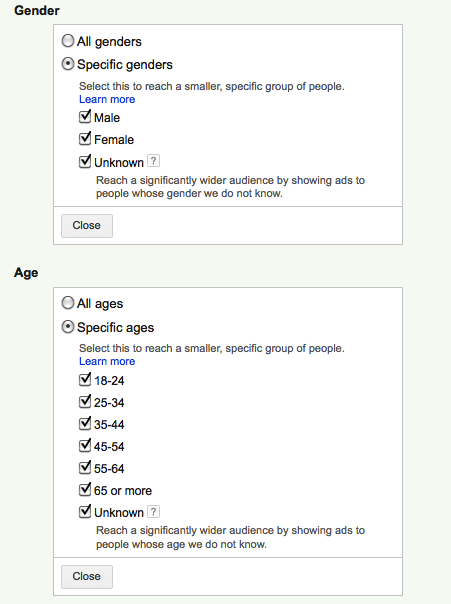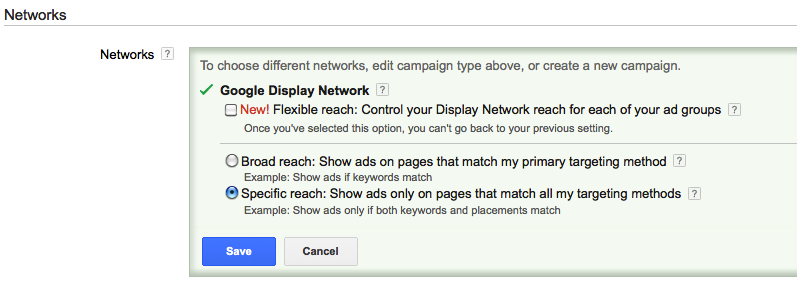In a roll out that’s been going on for months, demographic targeting should now be available to pretty much all users on the Google Display Network. Our bigger accounts have had it for some time while it’s still news to our smaller clients.
Google’s tried releasing demographic targeting in the past (check out this news post from 2008 when it was a beta back then), but now that this feature is in wide release, I’d say it’s time to really get the most from it. It’s been released and shuttered in the past, but it seems like Google’s serious about it this time. Hopefully the kinks have all been worked out by now. It’s time to optimize.
Now if you’re as savvy as reader/commenter Tomas (who alerted me to this new feature all the way back in August), you might have demo targeting enabled for your campaigns already. If you’re one of those people, you won’t need the below steps. But for the rest of ya’s, here are the steps to set it up:
Go to the Display Network tab in the AdWords interface. From any sub-tab within there, click on the “Change display targeting” button at the top. You’ll then select which ad group you’ll want to add demo targeting to, then choose your own adventure.
Keep in mind that Unknown categories are going to apply to a whole lot of internet eyeballs, so I wouldn’t recommend excluding those right away. That’s also where Google says children are filtered, so keep that in mind if you’re only looking for adults. (If you’re curious about your own behavior-inferred Google age and demographic, this link is always fun. It can even change from browser to browser if you use multiple.)
Before you even start adding in the demo targets to your campaigns, you should double check and make sure that you’re targeting a specific reach.
If you want to make the most out of the new targeting methods, you’ll have to start collecting data. The way to do this will be by adding all ages and genders to your display campaigns. You changed your settings to specific earlier because Google will show your ads to possibly the entire Internet if you opt in to demo targeting without first changing your campaigns to specific reach. I did that once for a single day on an old YouTube campaign and it was terrible. I still have fever dreams about it. Please don’t do that.
As far as I know, there isn’t a place in the editor to add in demographics, which is mildly-to-totally heartbreaking. You’ll have to ad this stuff ad group by ad group, which can be a long and arduous process depending on the size of your account. If you know of a way to do this in the editor, please share in the comments, but I couldn’t find it. For now, we’ll just add it to the wish list as we all collectively dream of a new version of the editor.
Once you’ve been opted into demo targeting for a enough time you’ll be able to optimize to the data. Just what types of optimization will you be able to accomplish?
- More consumer insight.
Some of my clients have a good grasp on who they’re targeting and we operate every day with that knowledge. If you’re in that position, it’s worth a test to see if maybe there are new demos that they could target. If you aren’t in that position yet, you can use demo targeting to actually find your ideal customer. And once you have your ideal customer your life will be so much better.
- More specific bids.
Different age customers may have different values for you. Once you know your target audience you can set up ad groups that allow for a higher CPL threshold knowing that they will have a higher probability of translating to sales.
(Keep in mind that demo-specific bids will only apply to campaigns that aren’t on enhanced CPC or CPA bidding. This works pretty much the same way as it does for other targeting methods on the Display Network, so you should be used to that, but keep it in mind.)
- More specificity in your targeting.
Now you can layer keywords with demos, topics with demos, interest categories with demos, demos with demos, Legos with Legos, Legos with Eggos, waffles with pancakes! Sorry. I got a little carried away.
The more specific your targeting, the more specific you can be with your ad text and landing pages. This probably deserves its own bullet. Hold on.
- More specificity with your ad text and landing pages
Ah, doesn’t that feel better? If you create a display campaign that has all of the same ad groups and targeting in duplicate, you can have one for men and one for women. I’ve heard that they are different. Different behaviors lead to different motivations which deserve their own ad text.
This same line of thought can apply to ages as well. 18-24 year olds will probably respond to text about parents just not understanding, while 35-44 year olds will respond to text about providing for their young children. (And yes, I do think that there’s a Will Smith song that each generation can define themselves by.)
Sure, demographic targeting is a bit creepy, but that’s how you know Google is doing it right (think of the strong correlation between the creepiness of remarketing and the awesomeness of remarketing). The first step of this process is getting out there and gathering the data. Once you see what user behaviors are, you can streamline your display network campaigns and make the most out of Google’s oldest new feature.






